A Club of Their Own Part IV
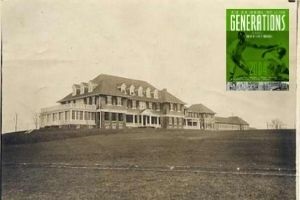
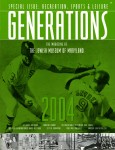 Article by Dr. Deborah R. Weiner. Originally published in Generations – 2004: Recreation, Sports & Leisure. This particular issue of Generations proved wildly popular and is no longer available for purchase.
Article by Dr. Deborah R. Weiner. Originally published in Generations – 2004: Recreation, Sports & Leisure. This particular issue of Generations proved wildly popular and is no longer available for purchase.
Part IV: Sporting and Cavorting
Miss parts 1-3? Start at the beginning.
Continuity and change have marked social life at Woodholme and Suburban. In the beginning, Suburbanites took the trolley out to the club for Saturday night dances. “It is said that there were some wild moments on the last trolleys back to the city around midnight,” reveals the Suburban Club history. For more sedentary members, card-playing proved popular, with separate card rooms for men and women, a standard country club feature. In 1905 the club found it necessary to make rules “to regulate the play of bridge whist by ladies.” Whatever unruly behavior may have occurred did so in elegant fashion, however, since a strict dress code applied. Home-grown productions entertained members from the start, from a 1911 Minstrel Show by the Suburban Flyers to a poolside fashion show some years later, where “Suburban member-models wore the latest fashions from Hutzler’s, Hochschild’s, and Schleisner’s downtown department stores.” Presumably they had no problem obtaining the right outfits, since the stores were all owned by club members.[1]
In the thirties and forties, the Suburban Club “was THE place to be,” says Mary Louise (“Wheezie”) Gutman. “I can remember we went there every Saturday night, and if you didn’t have a date to go there you were considered a lemon.” The unheated clubhouse closed for the cold months, during which time the Phoenix Club took over as German Jewry’s social center (the two clubs had virtually identical membership rosters). “The Phoenix Club’s china used to go to the Suburban Club for the summer and go back to the Phoenix Club in the winter,” Arthur Gutman relates.[2]
At Woodholme, an initial focus on golf and the nation’s plunge into Depression made for a somewhat slow start for the social scene, but with the building of a new clubhouse in 1948, the club came into its own. In fact, both clubs entered their glory years in the late forties. With the Depression and World War II fading into memory, Americans in the postwar era were in the mood to play, and the two clubs had the means to do it in style. Both hosted a lively round of dances, shows, parties, and games of all sorts. Woodholme was “the hub of athletic and social activities for the membership,” says longtime member Paul Goldberg. “No matter what you did on a Saturday night, you always gravitated back to the club…There was always a band, there was always dancing. It was the place to go.”[3]
Woodholme’s social scene tended to be more casual than Suburban’s, and more open to outsiders. Goldberg, a native East Baltimorean who moved back to the old neighborhood after military service in World War II, splurged on a membership because he wanted to play golf. He knew few Woodholme members, so to fill out his membership application, “I managed to dredge up three or four names of people I knew casually,” he says. “But they took me anyway because I was single.” It was “very, very easy” to get to know people: his first day on the course, the golf pro fixed him up with a threesome just starting out. The atmosphere was of “a small family group,” but one that welcomed new members.
One especially festive winter night in 1958, Harry and Marilyn Meyerhoff hosted a luau, with decorations “flown in from the islands especially for the part,” according to the Baltimore Sun. Birds of paradise, eucalyptus palms, and a thatch-roofed bar set the proper atmosphere. Even the invitations were written in Hawaiian (with English translation); Goldberg recalls going to the Pratt library to look up the words to respond in kind. Female guests came in grass skirts, muumuus, and sarongs, while the men donned “aloha shirts” and straw hats. Mr. and Mrs. Archie Wolfsheimer came dressed as cans of pineapple. Marilyn Meyerhoff’s outfit, described in detail by the Sun, featured “a bra made entirely of orchids.” The party, remembered to this day by many of the guests, cost nearly $10,000, making it “one of Baltimore’s more expensive private parties of the past year or so,” estimated the Sun. The festivities broke up after 3 a.m. Until then, guests dined on, among other things, barbequed shrimp and spare ribs, bacon slices wrapped around Spanish melon, lobster in avocado sauce, crabmeat on buttered toast, and the featured entrée, roast suckling pig.[4]
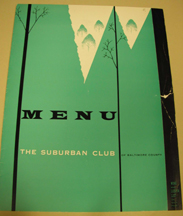
Not exactly a kosher menu, but neither Woodholme nor Suburban ever worried about such matters. From the Seafood Supreme served at one early Suburban luncheon to the Deluxe Seafood Bar on offer at Woodholme’s 75th anniversary celebration in 2002, the clubs’ chefs have focused on pleasing their members’ taste buds, not reflecting their religious affiliation. In fact, there has been little overtly “Jewish” in the clubs’ policies or daily operations. As the Suburban history points out, “there is no intent stated in the charter, bylaws, or minutes to serve only the Jewish community.” In the mid-1930s, the rabbis of the three Reform congregations asked Suburban officials to close the facilities on Yom Kippur. “The Board decided there was no reason to change longstanding practice and the Club would remain open,” the board minutes relate. However, the board later reversed the policy – and began the practice of giving Reform rabbis complimentary memberships. In later years, the Club offered a Shabbat menu at Friday dinner, “but the few orders received for it brought about its demise,” notes the Suburban history. (Recently, this option has reappeared on the menu, members say.”[5]
There has been one major exception to the lack of “Jewishness” in official club policies. Both Woodholme and Suburban have fostered a sense of communal responsibility, requiring their members not only to contribute to charity, but also to support Jewish philanthropies with at least a portion of their charitable dollars. “If you’re lucky enough to belong to a country club, Suburban member Ann Neumann Libov points out, “you’re lucky enough to give to charity, and especially support the Jewish community.” AS early as 1927, the suburban board voted to consider charitable contributions in selecting members, and in 1937 required that members contribute at least $50 per year to the Associated Jewish Charities. Today, Suburban members must give a percentage of their dues amount to charity, and at least half of that is expected to go to the Associated or Associated agencies. Woodholme members’ charitable contributions must match their dues amount, and they must also give a certain portion to the Associated.[6]
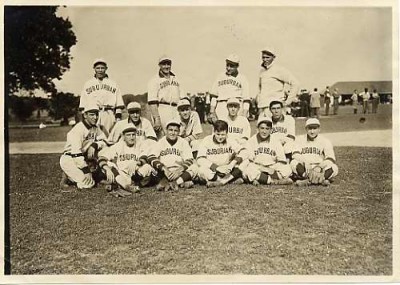
Nevertheless, country clubs are not charities, their raison d’être is recreation, and sports have featured prominently at both Suburban and Woodholme. In the early 1900s, baseball reigned supreme in America, and every club had its amateur team. The Suburban Club played against other clubs in the area, and the competition as serious – it was not unknown for a team to have one or two non-member “ringers.” While the sport was wildly popular with spectators, it had relatively few participants. In 1928, in a clear sign of the times, the baseball team was dissolved because its diamond was needed for an urgent cause: a parking lot. On the other hand, swimming and tennis drew many players at Suburban, attracted by championship-quality facilities. Suburban produced male and female champions in both sports over the years, including Wheezie Gutman, who in her early twenties won the women’s city tennis championship. She attributes the success of Suburban’s tennis program to “the finest clay courts in Baltimore” and the coaching of the club’s tennis professionals.[7]
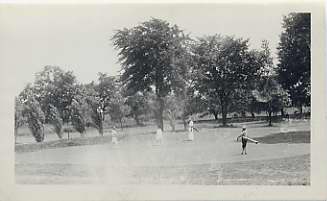
But everywhere, “golf is the anchor of the country club,” as one interviewee put it. Until recently, public golf courses were not very good, so anyone who truly wanted to play had to join a club. At Woodholme, even with today’s high-end public courses, golf is still “the primary lure,” says Paul Goldberg. That’s because of Woodholme’s championship-level course, a challenging 18 holes that serious golfers continue to relish playing. Although a poll was first built in 1938 and tennis enjoyed its moment of glory from the fifties to the eighties, golf has always been the club’s pride and joy. In fact, according to former member Sewell Sugar, “Woodholme evolved from a simple, male-oriented golf club” into a “full blown country club” only over a period of decades.[8]
Male-oriented, that is, until the legendary Evelyn Glick came along. The wife of a Woodholme member, Glick took up golf at age 30 and proceeded to dominate the women’s amateur scene in Maryland from the 1940s to the 1960s. From her base at Woodholme, Glick was the “undisputed queen of the fairways,” reported the Baltimore Sun in 1956. Winner of numerous city, state, and regional championships, she was inducted in to the Maryland Athletic Hall of Fame in 1977. “Whatever she did, she did full blast,” Sugar recalls.[9]
Continue to Part V: Controversies and Changing Times
Notes:
[1] The Suburban Club, 60-62.
[2] Arthur and Wheezie Gutman interview; The Suburban Club, 63.
[3] “About Our Club” (JMM Vertical Files, courtesy of Woodholme Country Club); Pail Goldberg, phone interview with author, December 2004.
[4] Audrey Bishop, “If Winter Comes – An Indoor Luau,” Baltimore Sun, January 26, 1958.
[5] Suburban Club menu, JMM 1990.233.4; Woodholme anniversary program (JMM Vertical Files, courtesy of Woodholme Country Club); The Suburban Club, 22, 32, 34, 42, 70; various interviews.
[6] The Suburban Club, 44; Ann Neuman Libov, phone interview with author, December 2004; Mitchell Platt, interview with author, December 9, 2004.
[7] The Suburban Club, 73-77; Wheezie Gutman interview.
[8] Sewell Sugar, phone interview with author, December 2004.
[9] Fred Rasmussen, “Evelyn G. Glick, 87, Golfer,” Baltimore Sun, October 18, 1998 (obituary); “Woodholme Club ‘Becomes of Age,’” Baltimore Sun, April 1, 1956; Sugar interview.
